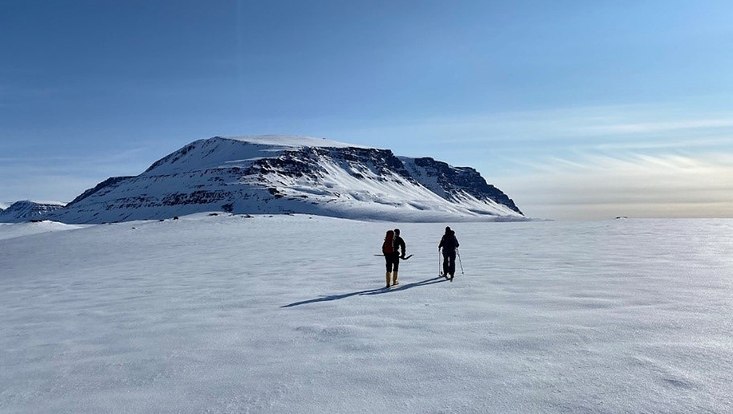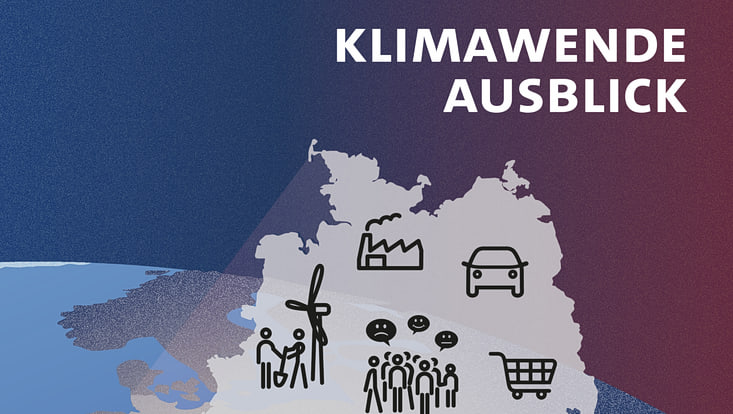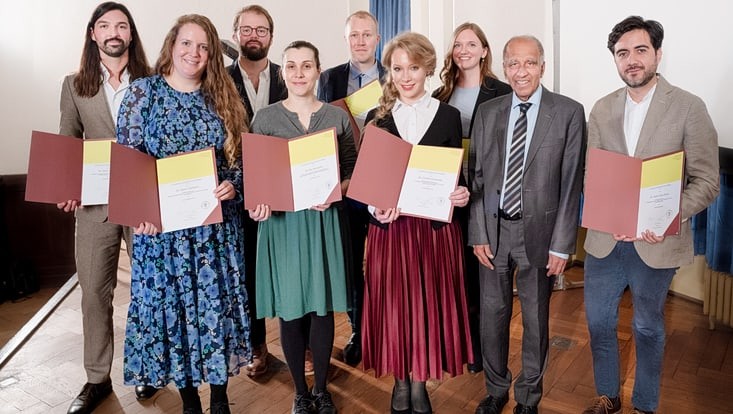and Society (CLICCS)
Greenhouse gases from the ArcticWinter Expedition to Greenland Launched
4 April 2024, by Christina Steffens

Photo: Lars Kutzbach
Experts from the Cluster of Excellence “Climate, Climatic Change, and Society” (CLICCS) and the joint project MOMENT are working together to explore which factors affect the carbon cycle in general and the methane concentrations in particular in Blæsedalen (“the windy valley”) on Greenland’s Disko Island. This year’s expedition began in April, when it was still winter in the valley: to gain as complete a grasp of the carbon cycle and methane fluxes as possible, all seasons need to be included.
In 2022, Disko Island was first explored as a new permafrost-influenced Arctic research area for Hamburg’s climate experts, and a collaboration was founded with the “Arctic Station UC,” a research base located north of Qeqertarsuaq. Last year, the field labs for the two projects were set up in early summer and extensive fieldwork was conducted through the summer and fall. This year, additional fieldwork will commence in April, when the ground is still completely frozen and the snow cover is intact. To guarantee their safety during these winter expeditions, the researchers are accompanied by a local hunter, who ensures there are no close encounters with polar bears.
What happens to the dissolved carbon in melting snow?
This question preoccupies Dr. Evan Wilcox and Oliver Kaufmann from the Institute of Soil Sciences at Universität Hamburg (CLICCS Project A1). To find answers, they’ll engage in fieldwork on Greenland’s Disko Island from April to June. “Our goals this spring are twofold: we plan to estimate the amount of carbon exported by a headwater, unglaciated stream in the Blæsedalen Valley, and to investigate how soil properties affect the infiltration of snowmelt runoff,” says Wilcox. The researchers will collect water samples at the beginning of the stream, gather soil samples both before and after the snow melts, and extract soil pore water. The samples will then go to the lab, where the concentration of dissolved carbon will be determined and detailed carbon and water isotope analyses will be conducted. Isotopes are variants of a given element with different atomic weights, which are due to differing numbers of neutrons. The lab results will make it possible to estimate what percentage of groundwater is replaced by meltwater and the respective concentrations of groundwater and meltwater that can be found in the stream’s water. This data will also provide insights into how Disko Island’s carbon budget is changing in response to lasting changes in the region’s snowfall, caused by climate change.
Which factors affect methane emissions?
The joint project “MOMENT” is seeking to answer that question. Last year, researchers from Universität Hamburg’s Institute of Soil Sciences measured surface methane fluxes along three moisture gradients and near selected characteristic structures. This year, Selina Undeutsch will continue the measurements, to cover all seasons.
This April, Prof. Dr. Susanne Liebner and Dr. Claudia Bruhn from the Helmholtz Centre GFZ German Research Centre for Geosciences in Potsdam will return to the same sites as in July and September of last year, gathering samples for a third and final time. In turn, their soil samples will be prepared for molecular-biological analyses in the lab. “We want to find out what happens to the soil microbiome in winter, when the soil is completely frozen,” explains Dr. Claudia Bruhn.
Also in April, Bill Cable from the Alfred Wegener Institute, Helmholtz Centre for Polar and Marine Research in Potsdam (AWI Potsdam) and Dr. Lars-Hendrik Mewes, a snow physicist at Swiss-based SLF, will measure the spatial distribution of snow cover and assess the snow’s microstructure and the thermal properties of snow cover. “Here, our scientific objective is to better grasp how snow cover affects soil temperatures and soil moisture levels in interplay with vegetation,” says Dr. Simone M. Stünzi from the AWI Potsdam. Since last year, the soil moisture and temperature have been continuously monitored by automatic sensors installed on location. These two factors are important in terms of shaping the development of soil organisms, including microbes, which means they also influence CO2 and methane fluxes at the soil’s surface.
Whereas the soil of the tundra is frozen in winter, the sediment below the lake at the research site remains frost-free year-round, which means methane can also be produced and released into the water column in winter. When the snow melted last year, relatively high methane emissions were recorded along the margins of the shrinking ice cover. “Now our goal is to find out how much methane accumulates in the lake water and in the lake’s ice cover over the long winter,” explains Prof. Torsten Sachs from the Helmholtz Centre GFZ German Research Centre for Geosciences in Potsdam.
More information
Cluster of Excellence CLICCS
The Cluster of Excellence “Climate, Climatic Change, and Society” (CLICCS) at Universität Hamburg investigates fundamental aspects of climate change, both from a natural sciences perspective and with regard to societal developments, and assesses which future developments (“climate futures” are not just possible, but plausible. Further, CLICCS regularly provides recommendations for political decisionmakers on the basis of its foundational research. The Cluster is funded by the German Research Foundation (DFG).
Joint Project MOMENT
The project MOMENT (Permafrost Research Towards Integrated Observation and Modelling of the Methane Budget of Ecosystems) will close important gaps in the process understanding of the methane cycle in northern latitudes using innovative laboratory studies and multi-scale methane flux observations on Disko Island, Greenland based on state-of-the-art infrastructure.
The joint project MOMENT is funded by the German Federal Ministry of Education and Research (BMBF) and is slated to run for three years, from November 2022 to October 2025.


